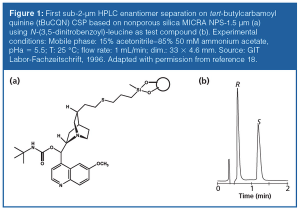Articles by Wolfgang Lindner

Enantioselective high performance liquid chromatography (HPLC) is slowly adopting the modern particle technologies (sub-2-µm fully porous particles [FPPs] and sub-3-µm superficially porous silica particles [SPPs]) that have been well known in reversed-phase LC for the past decade. The most significant benefit is that enantiomer separations can be performed much faster, which is of interest in high-throughput screening applications and multidimensional enantioselective HPLC analysis. The state of the art is briefly discussed with some examples documenting the potential of core–shell particle technology and comprehensive multidimensional separations.

W. John Lough from the University of Sunderland, UK, in conversation with (old) friends from academia and industry to celebrate 60 years of advances in chromatography.

Therapeutic peptides represent one of the fastest growing segments in the pharmaceutical market. To bring these products to the market in a consistent manner, high quality is a major concern and requires stringent quality control (QC) methods. This article discusses the potential of zwitterionic chiral ion-exchangers to support peptide analysis and quality control as a flexible complementary tool to monitor the stereochemical integrity and chemical modifications.

The hills will be alive with the sound of chromatography when the 30th International Symposium on Chromatography (ISC 2014) takes place from 14?18 September 2014 in Salzburg, Austria.

The hills will be alive with the sound of chromatography when the 30th International Symposium on Chromatography (ISC 2014) takes place from 14–18 September 2014 in Salzburg, Austria.

Quinine- and quinidine-derived anion-exchanger chiral stationary phases have proven to be versatile in enantiomer separation of acidic compounds in HPLC. In this article, the authors demonstrate their performance in specific HPLC applications involving enantiomer resolution and topoisomer separation.








